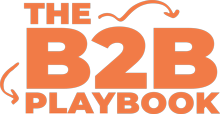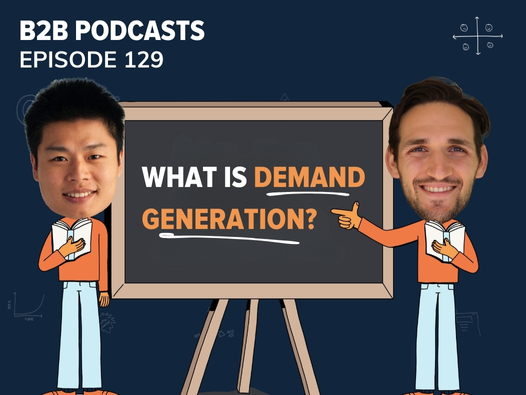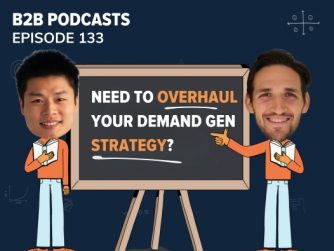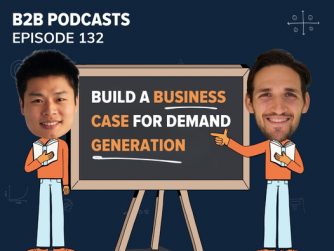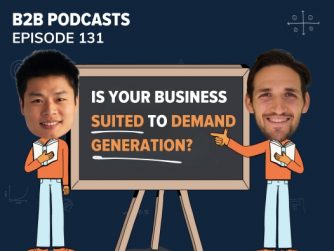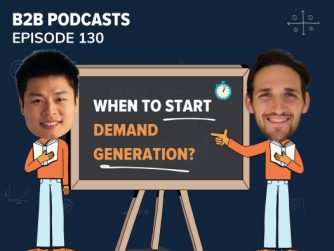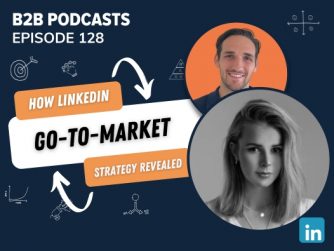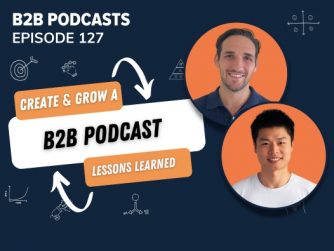There are so many different definitions of Demand Generation, often written by self-serving tech companies to then make you think you HAVE to buy their software to help you execute it. Demand generation is all we do here at The B2B Playbook. We’re practice it, we teach it, and we share our no-nonsense 5 BEs Framework to execute it.
So in this guide, we’re going to first tell you exactly what demand generation is, and what its core components are. We’ll then explain exactly why a business should invest in it. We’re then going to show you the difference between demand generation vs lead generation, and demand generation vs brand marketing.
I’ll then share our favourite framework to keep in mind that’s really going to simplify how you think about demand generation.
Buckle up, because I’m getting the whiteboard out for this one!
Listen To The Episode
Watch The Episode
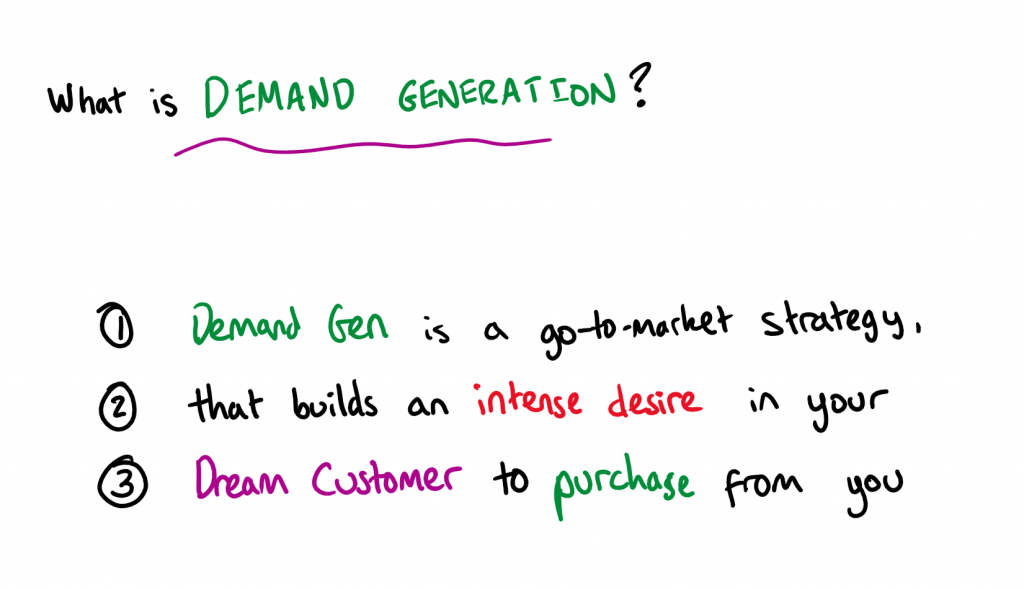
What Is Demand Generation?
Demand Generation is a go-to-market strategy that builds an intense desire in your Dream Customer to purchase from you.
Okay, that’s a bit of a mouthful.
Let’s break down each of those components:
- A go-to-market strategy
- That builds an intense desire
- In your Dream Customer to purchase from you
We’ll handle them one by one below.
Demand Gen is a Go-To-Market Strategy
We say Demand Generation is a ‘go-to-market’ strategy. What does that mean?
A go-to-market strategy is a step-by-step plan designed to bring a product to market and drive demand. It’s the plan that gets your product in front of your Dream Customers, and convinces them to buy from you.
We believe that go-to-market strategies should align with business goals, have KPIs to measure their success and be documented as a plan.
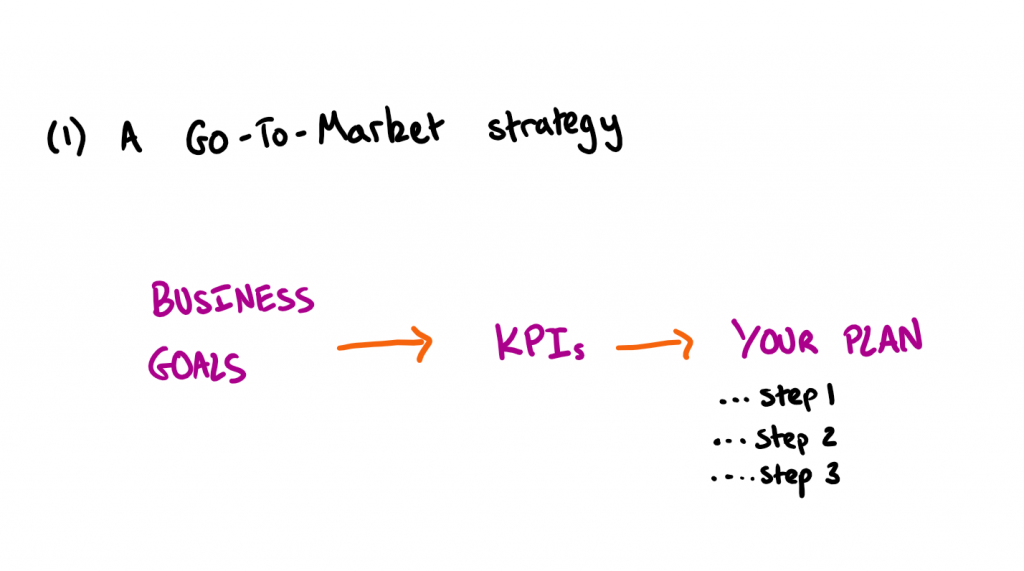
Go-to-market strategies help ensure you’re aligned with the strategic priorities of the business. Planning, documenting and measuring them also ensures there’s accountability in their execution.
Demand Gen Builds an Intense Desire
Demand Gen also builds an intense desire in your Dream Customer.
There’s two parts here – first of all, driving an intense desire. Your potential customer receives emails and cold calls with people trying to sell them stuff every day. Often, people are trying to sell them stuff that they actually need and will help them. But they ignore it.
So to build this intense desire in a person to buy from you, you first need to make them prioritise the pain that you can provide the solution to. It needs to be so painful that it goes to the top of their priority list. And then, you need to make them want to buy it from you, over anyone else.
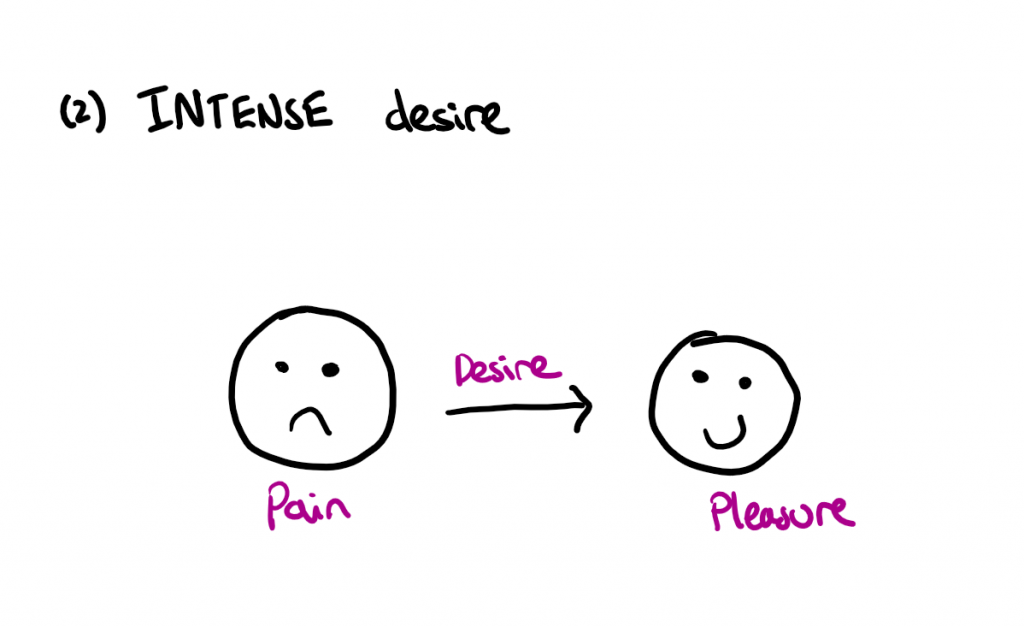
For example, we recently purchased cybersecurity insurance. Pretty much every business should have it, but as a younger business there’s many competing priorities, and it just got put on the back burner.
I’d even completely forgotten about it! That was until Kevin shared an article with me that scared me. It was about a business quite similar to ours that was hacked, with the hackers releasing the passwords of all their clients. Without cybersecurity insurance, this company was doomed.
This article (likely a PR piece commissioned by the cybersecurity company) scared me straight, and put cybersecurity insurance straight to the top of our priorities. Two weeks later (after Kevin had done his deep research), and we purchased it.
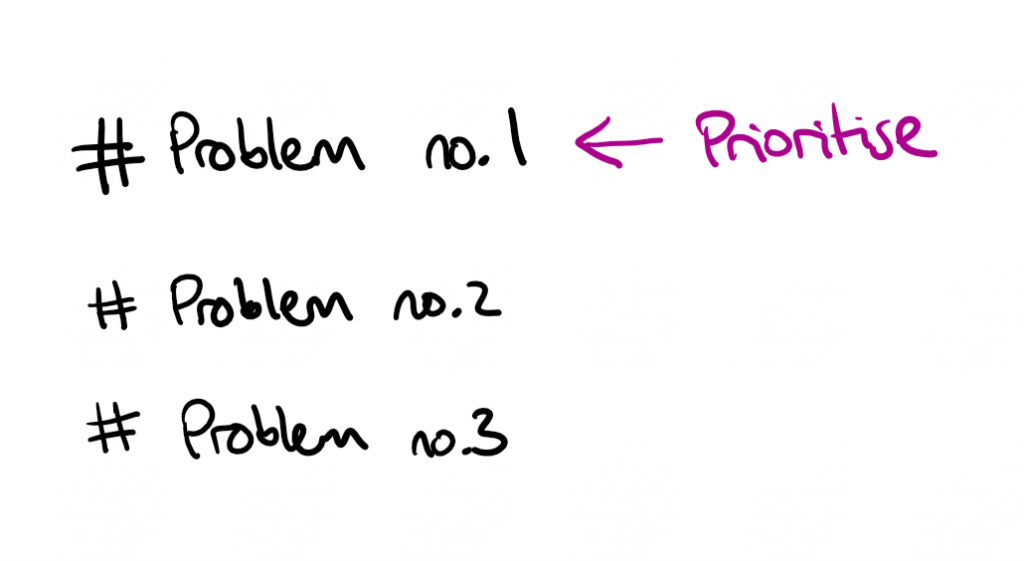
All of a sudden, this article put cybersecurity as a problem right to the top of my priority list. That’s what your marketing needs to do.
The second part is the ‘Dream Customer’. Your Dream Customer is not your Total Addressable Market (TAM). It’s a segment of this TAM that are more likely to prioritise the pain you help solve, and that you have the resources to win over.
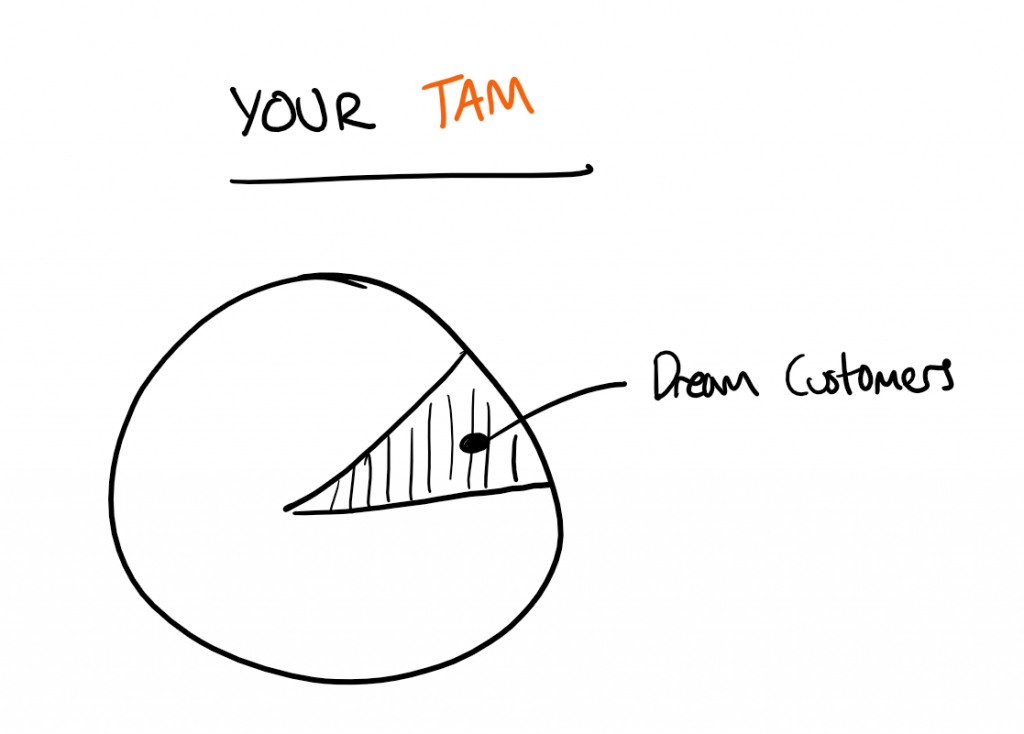
We have a process to help you understand what Segment you should target and make your Dream Customers. We cover this in ‘Be Ready’ – the first step in our 5 BEs Framework for Demand Generation. You can check this out here.
Demand Gen Gets Dream Customers to Purchase from You
It’s not enough to make a Dream Customer feel the pain of the problem that you solve. You need to take the extra step, and make them want to buy this solution from you over your competition.
That means you need to show them that not only do they need to prioritise the problem you help fix, but that your solution is PERFECT for them, and unmatched by your rivals.
Much of this comes down to your positioning, messaging, and how you build trust with your Dream Customers earlier in their buying journey
The Two Core Components to Demand Generation
Demand generation can really be broken down into two key components: creating demand, and capturing demand.
Capturing demand is about targeting and trying to win over companies that are actively looking for a product or solution like yours right now – which makes up just 3-5% of the market (research from The B2B Institute – the 95:5 rule).
Creating demand looks to the other 95% of the market who not ready to buy yet. This is either because they’re unaware they have a problem you can help them with, or haven’t prioritised the problem yet

Before we go into these and why they’re both important, it’s helpful to first look at a framework for the buying journey and understand a bit more about that.
The B2B Buying Journey – 5 Stages of Awareness
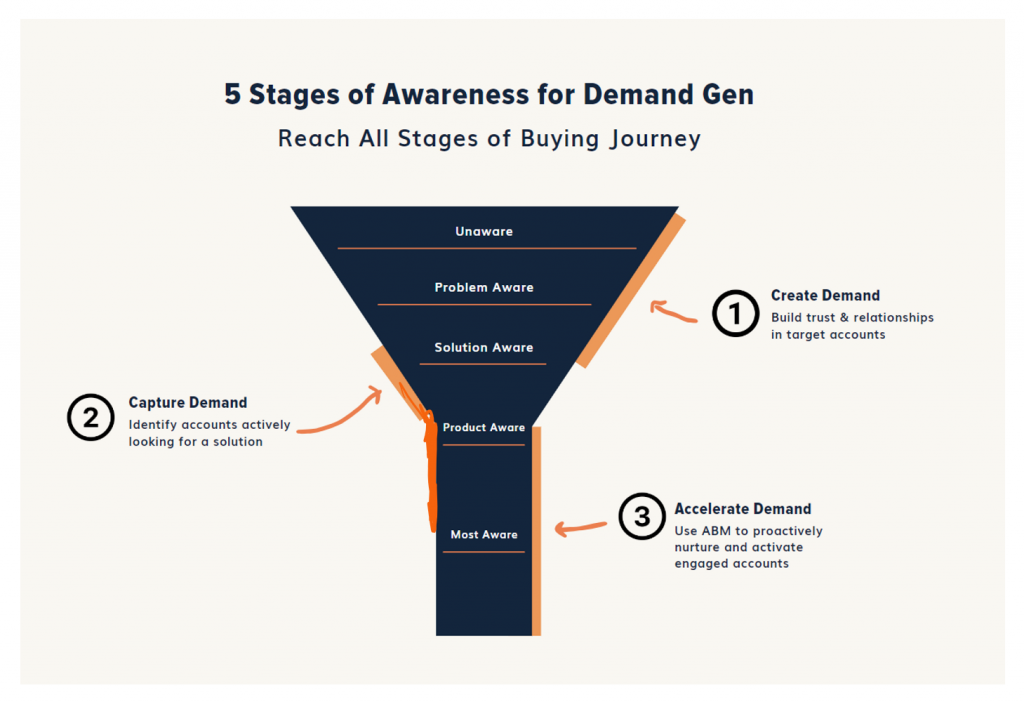
Every buyer has their own unique journey to purchase, but a great Framework to think about their journey is The 5 Stages of Awareness.
The 5 Stages of Awareness is the buying journey that a prospect will take from being Unaware that they even have a problem that you can help them with, to being led to the logical conclusion that you’re the perfect solution for them
A quick summary of each of these 5 stages:
- Unaware: At this stage, potential customers are not even aware that they have a problem or a need that your product or service can address.
- By volume they’re the largest segment, but also the most challenging to market to
- By volume they’re the largest segment, but also the most challenging to market to
- Problem Aware: Here, customers realize they have a problem but may not know the solutions available.
- They have lots of questions here at this point
- They have lots of questions here at this point
- Solution Aware: Customers are aware of various solutions to their problem but may not be familiar with your specific product or service.
- They don’t know about you or what you offer, but they want to sort out the problem
- They don’t know about you or what you offer, but they want to sort out the problem
- Product Aware: In this stage, customers know about your product or service but are still comparing it with other options in the market.
- Your prospect is now looking at all options, including yours
- Your prospect is now looking at all options, including yours
- Most Aware: Finally, customers are fully aware of your product, including its benefits and how it compares to competitors. They are on the brink of making a purchase decision.
- They need a final nudge to pull out the credit card
Most Marketers Focus On Capturing Demand
Looking at our previous graph of the 5 Stages of Awareness, most marketers focus on buyers that are solution aware, product aware and most aware. They’re later in their buying journey, and this is what we’d call ‘Capturing Demand’ – targeting buyers that are in-market, right now.
Typical demand capture activities might be running Google Ads, targeting keywords searched by people who are looking to buy a product like yours right now. If for example, you’re selling a CRM designed for sales people – you might bid on the search “CRM for growing sales teams”. You might also capture demand from people searching on review platforms like G2
These activities are a great place to start, but they don’t SCALE. And the reason for that is that there’s only 3-5% of your market who are in ‘buy mode’ right now – the rest of the market aren’t. So as you grow, both you and your competitors are trying to capture a bigger piece of the same sized pie. If your market isn’t expanding and the competition is increasing, your costs go up and it becomes unsustainable.

Add into the mix the research from Bain & Co that shows that 80-90% of buyers buy the brand that came to mind first on Day 1 – and that means only 20% of buyers in market that will consider buying from you if they haven’t heard from you before and you’re only capturing demand. So really 0.6% of in market buyers are available to you, not 3% if you’re doing demand capture alone
I’ve experienced this pain of not being able to scale many times myself as a performance marketer. It’s an awful feeling that feels you with anxiety, wondering why you can’t continue the initial success you had as the business tries to scale.
Why You Need To Dedicate Resources to Creating Demand Too
Demand creation looks at the other 97% of the market who are not in ‘buy mode’. They’re people who are problem aware or even unaware of the solution your product/service solves.
Your job with demand creation is to build a relationship and win their trust, make them prioritise that problem, and lead them to the logical conclusion that you’re the best product/service available for fixing it.
This allows you to scale beyond the 3% in ‘buy mode’ right now, and build relationships of trust with Dream Customers that your competitors aren’t even interacting with. Not only does that make it cheaper to market to them because there’s less competition, but your marketing efforts mean they’ll be more likely to buy from you over the competition once they’re in-market.
This is what we’ve detailed in our 5 BEs Framework for demand generation, as we found there wasn’t a lot of information on how to do this properly.
Note: A healthy demand generation engine should both create and capture demand.
Why Demand Creation is Your Competitive Advantage
Below is one more graph to illustrate the competitive advantage that demand creation gives you.
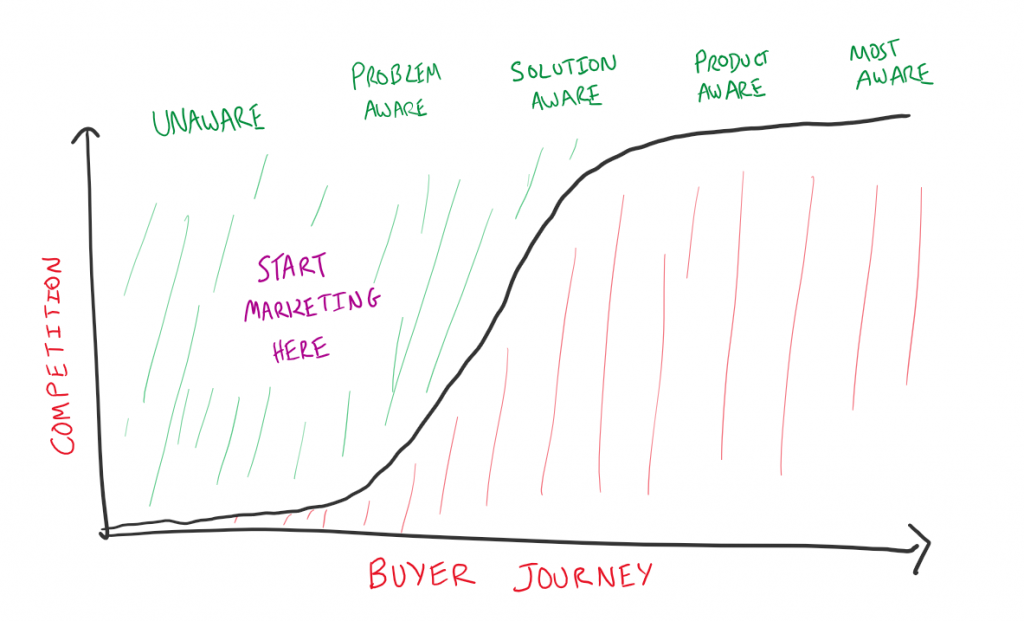
On the Y axis, we have competition, and on the X we have the buying journey. We can see that competition increases for your Dream Customers’ attention as they progress throughout the buying journey.
That leaves an opportunity to savvy marketers to start marketing to Dream Customers that are earlier in their buying journey. B2B is all about building trust, and this gives you a unique opportunity to build that trust between your brand and the customer well before they’re in-market and ready to buy.
Demand Generation vs Brand Marketing
Occasionally, marketers confuse Demand Generation (in particular demand creation) with Brand Marketing.
Brand Marketing typically involves building brand awareness, establishing and promoting a company’s brand identity, values, and connection with its audience. The goal is to create a positive perception of the brand that attracts and retains customers over time, often without a direct call to action that leads to immediate sales.
While there is some overlap, Demand Generation is focused on creating demand for a product or service through educational and engaging marketing strategies that lead potential customers through the buyer’s journey. It is highly strategic, tactical and targeted, aiming to generate high-quality opportunities that can be converted into sales, directly impacting revenue.
Demand Gen marketers also pride themselves on looking further down the funnel to tie their impact to bottom line metrics – like Opportunities and Revenue. They do their best to connect even their demand creation activities to pipeline.
Demand Generation vs Lead Generation
How is Demand Generation different to Lead Generation?
Lead generation is often presented as the antithesis to Demand Generation – but it shouldn’t be. In fact, well executed Lead Generation is very similar to capturing demand. It’s about identifying those that are actively in ‘buy mode’ – more likely solution aware + product aware and most aware’ – and capturing their contact information. And then nurturing them until they express enough intent for you to pass them onto sales.
This can include: requesting a demo, booking a free trial, or if you’re a little light on these – garnering intent based on their activities like visiting the pricing page multiple times.
The problem is that most companies incentivise their marketers to practise ‘bad’ lead generation. They’re incentivised to generate as many ‘MQLs’ (Marketing Qualified Leads) as possible – which are often poorly defined. This means that many marketers put together a gated eBook, and use ads to run it to their target audience in exchange for their contact details.
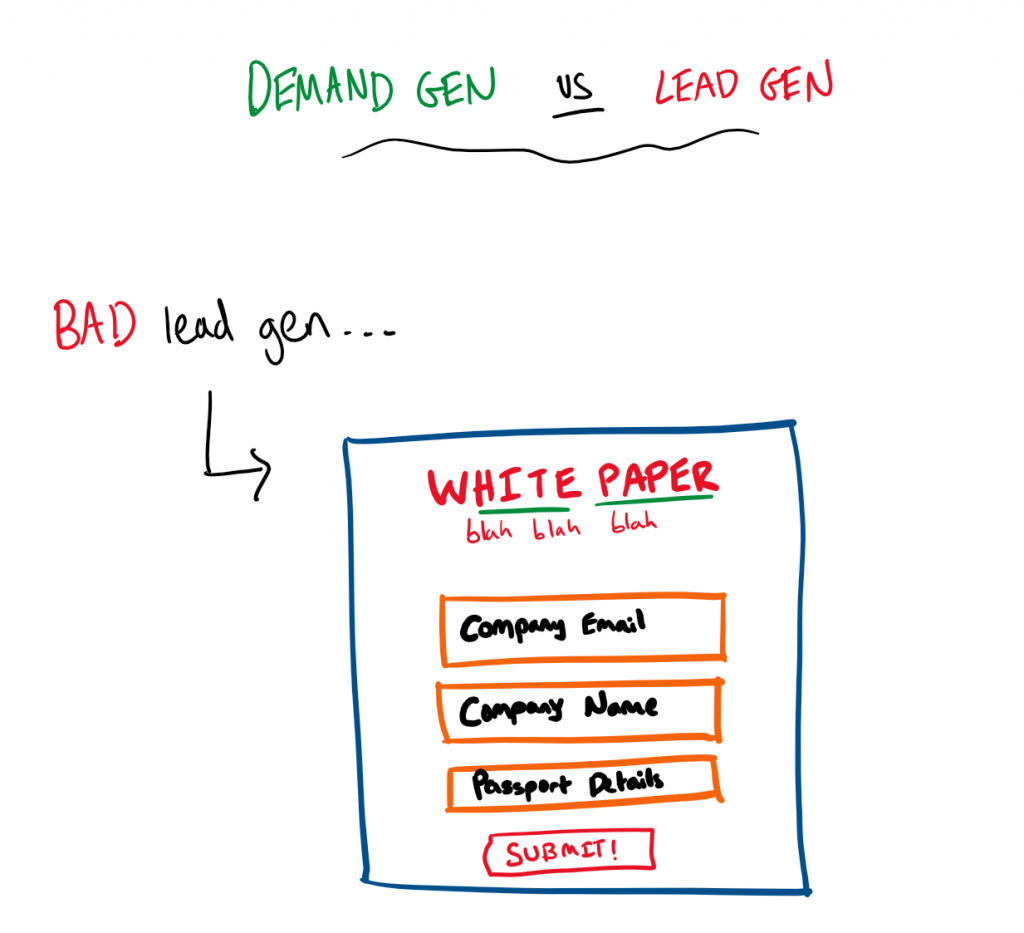
Marketing then shovel these contacts onto sales as ‘leads’.
Sales contact these leads, and most have no idea who the company is, and do not want to be contacted. It’s often a huge resources of time and money, as sales staff are hired to meet the number of ‘leads’ marketing is generating.
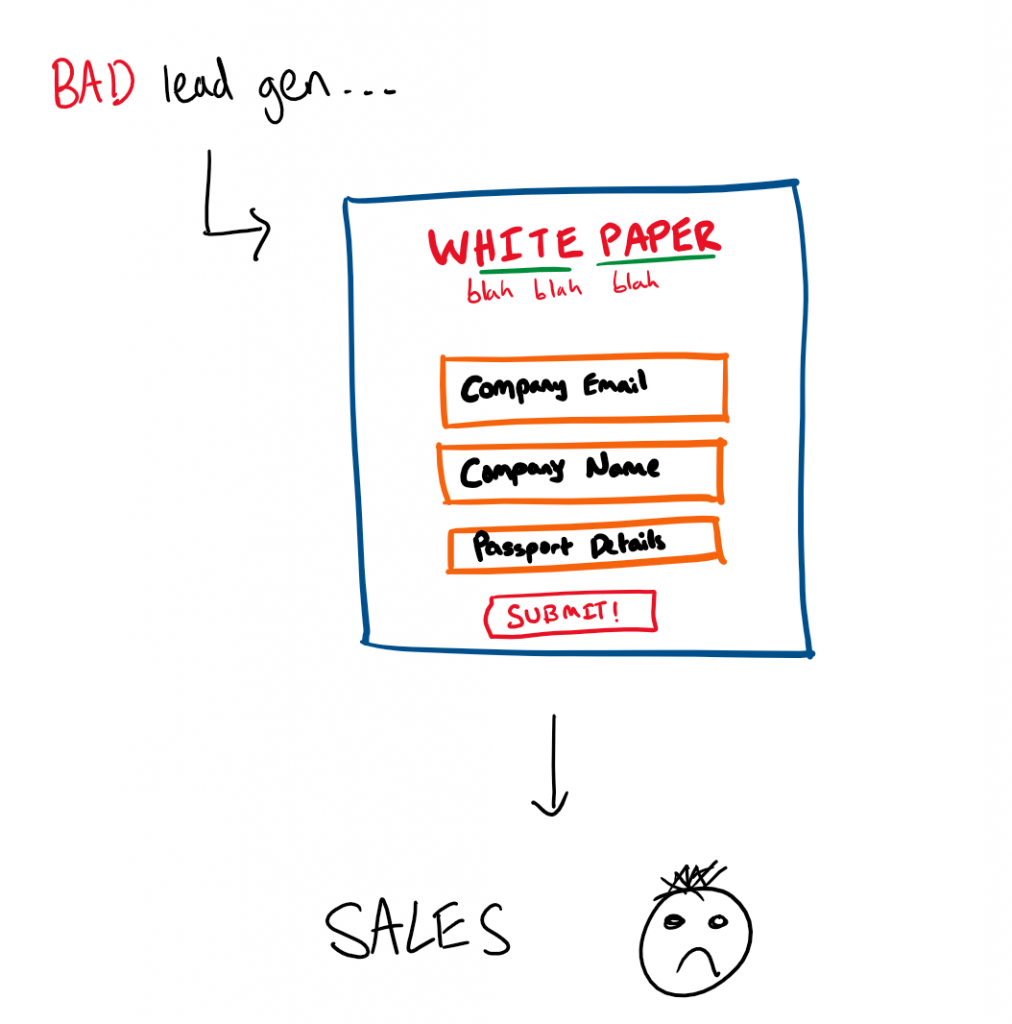
Not only does this start to drive a wedge between marketing and sales, because sales feel that marketing are wasting their time with junk leads – but you’ll see it’s a highly inefficient and unsustainable method of acquisition.
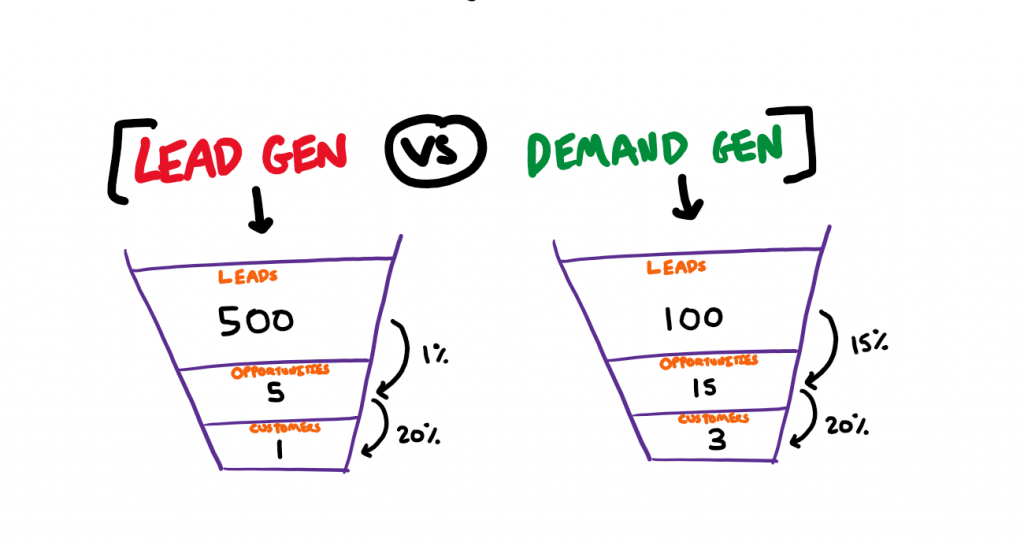
If you look at the number of Opportunities and Closed-Won deals that come from this kind of Lead Generation, you’ll see that it’s completely unsustainable – especially when you take into account the cost of Sales servicing all the no-intent leads you’re sending.
Organisations try and fix this with better qualification and lead scoring, so only the higher intent leads are sent to sales – which can work. But often organisations are spending so much to acquire contact details that they could have just purchased through a database for way cheaper.
In future articles, we’ll go into how to assess if if lead generation is stopping your from scaling, and how to make a business case to start investing more in demand generation.
Starting To Put Together Your Demand Generation Strategy
There are countless benefits to strong Demand Generation programs. It results in marketing starting to contribute better pipeline to the business, greater alignment between marketing and sales, and a much more efficient acquisition process that allows a business to scale.
You can see here a great demand gen example of how we used it to fuel our own business.
If you are ready to start exploring what a strong, tested and repeatable demand generation strategy looks like, check out our free guide here.
If you are ready to start implementing it in your own business, check out our 12 week program – The B2B Incubator, and join B2B marketers like you that are now driving 80% of pipeline for their business. Check it out here.
Create Your Demand Engine in 12 Weeks
B2B marketing strategy that shows you step-by-step how to drive revenue
